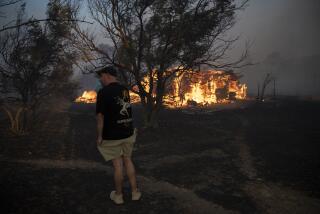Hot times in the city
Los Angeles’ accelerating quest to create centers of higher population density -- especially downtown, in Hollywood and in Mid-Wilshire -- may be on a collision course with California’s crusade to slow global warming by reducing its greenhouse gas emissions. And the potential trouble comes from an unlikely source -- buildings.
High-density development is usually considered environmentally friendly if it occurs near subway, rail or bus lines, and people can abandon their cars to get around. But unless people actually do take advantage of public transit and reduce their energy consumption, the environmental costs may outweigh the benefits.
One effect of high-density development that can potentially increase energy consumption is a phenomenon known as the “urban heat island.” This is principally caused by the construction materials -- brick, concrete, asphalt, stone and other substances -- used most often in building central cities. Because these materials retain heat and cool slowly, they raise the ambient air temperature and make central cities a few degrees warmer than rural and suburban areas. For instance, the temperature difference between Phoenix and its outlying areas can be upward of 10 degrees. The difference is even more pronounced at night because rural and suburban areas have fewer buildings, less concrete and asphalt and more vegetation, and thus cool faster.
Packing taller residential buildings closer together to increase density, without making room for significant areas of green space, such as parks or shaded plazas, only worsens the effect.
This is not an earth-shattering revelation. Researchers have known about the effect of the urban heat island on ambient air temperature for more than 100 years. More recently, however, heat-island studies of such cities as London, Athens, Tokyo, Beijing, Phoenix and Los Angeles have not only shown the problem worsening but have documented the rising level of energy consumption associated with it. The greater the density and the less green space nearby, the more severe the urban heat island can become.
Current research does not suggest that urban heat islands directly contribute to global warming. But they may be a factor in another way. The amount of greenhouse-gas-producing energy needed to operate buildings -- heating, cooling and lighting them -- makes up a significant portion of our overall energy consumption. Any phenomenon that increases the urban heat island effect -- such as more high-density development without consideration for green space and energy efficiency -- could potentially result in still-higher energy consumption and greenhouse gas emissions, primarily because of the greater use of air conditioning.
Just how much energy do buildings consume?
According to the Energy Department’s 2006 Building Energy Data Book, 39% of primary energy in the U.S. is consumed in buildings, accounting for 38% of annual carbon dioxide emissions. In addition, 68% of all energy consumed in residential buildings -- houses, apartment buildings, condo towers and so forth -- goes for heating (space and water), cooling and lighting. This energy consumption produces 66% of carbon dioxide emissions of all U.S. residential buildings.
Higher-density development, because it might worsen the urban heat island effect, could increase such energy consumption, especially the amount of energy used to cool high-rise apartment and condo complexes.
A study of Los Angeles by the Heat Island Group at the environmental energy technologies division of the Lawrence Berkeley National Laboratory suggests the amount of energy involved. It estimated that “the demand for electric power rises nearly 2% for every degree Fahrenheit the daily maximum temperature rises.” Compensating for the effect of the urban heat island could cost millions of dollars annually, and could result in significant increases in energy consumption and carbon dioxide emissions.
In such an environmentally friendly state as California, how green should new development in L.A. be? Has the possible effect of the urban heat island on global warming been fully evaluated?
Developers in California cities are not required to account for the effects of their buildings on global warming in their environmental impact reports. But that could change. In a recent lawsuit, state Atty. Gen. Jerry Brown targeted sprawl in San Bernardino County as a generator of global warming emissions. The county settled and will have to begin reducing its greenhouse gas emissions in the next 2 1/2 years.
Short of a lawsuit, there are many ways to lessen the potential warming effects of high-density development and its effect on energy consumption and carbon dioxide emissions. The Environmental Protection Agency’s Heat Island Reduction Initiative funds research into the problem, and the U.S. Green Building Council promotes construction and design practices that improve the energy efficiency of buildings. , These may include the green roofs and green walls that incorporate vegetation to improve the energy efficiency of buildings; and passive heating and cooling, which often involve natural ventilation or solar energy.
These practices can make future residential and office buildings more livable without the need to blast air conditioning units all day and into the night. Equally important is the creation of more green spaces because they help cool the ambient temperature.
Increasing density downtown and in other areas of Los Angeles need not intensify the urban heat island. We have the technological know-how to mitigate the problem. By using it to build more energy-efficient buildings, Los Angeles can be in the forefront of California’s campaign to promote the ideals of sustainable development and smart growth.
More to Read
Sign up for Essential California
The most important California stories and recommendations in your inbox every morning.
You may occasionally receive promotional content from the Los Angeles Times.









